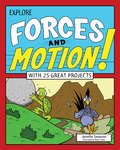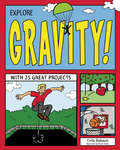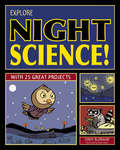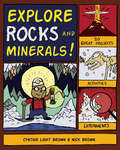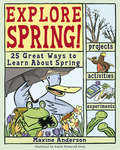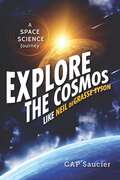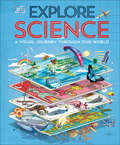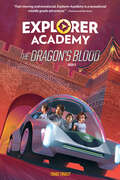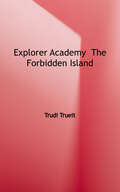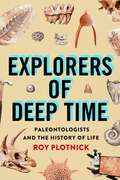- Table View
- List View
Explore Forces and Motion!
by Jennifer SwansonEverything moves! Kids run around the playground, cars drive on the road, and balls fly through the air. What causes all this motion? Physics! Forces and motion rule the way everything moves through space. In Explore Forces and Motion! With 25 Great Projects, readers ages 7 through 10 discover that the push and pull of every object on the planet and in space depends on how a force acts upon it. Things float because of a force called buoyancy, we stick to the ground because of a force called gravity, and we make footprints in sand because of a force called pressure. Physics becomes accessible and interactive through activities such as a experimenting with a water cup drop, building a bridge, and spotting magnetic field lines. Simple machines such as levers, pulleys, and wedges are used as vehicles for discovery and comprehension of the foundational concepts of physical science. Using a theme familiar to everyone--motion--this book captures the imagination and encourages young readers to push, pull, twist, turn, and spin their way to learning about forces and motion.
Explore Forces and Motion!
by Jennifer SwansonEverything moves! Kids run around the playground, cars drive on the road, and balls fly through the air. What causes all this motion? Physics! Forces and motion rule the way everything moves through space. In Explore Forces and Motion! With 25 Great Projects, readers ages 7 through 10 discover that the push and pull of every object on the planet and in space depends on how a force acts upon it. Things float because of a force called buoyancy, we stick to the ground because of a force called gravity, and we make footprints in sand because of a force called pressure. Physics becomes accessible and interactive through activities such as a experimenting with a water cup drop, building a bridge, and spotting magnetic field lines. Simple machines such as levers, pulleys, and wedges are used as vehicles for discovery and comprehension of the foundational concepts of physical science. Using a theme familiar to everyone--motion--this book captures the imagination and encourages young readers to push, pull, twist, turn, and spin their way to learning about forces and motion.
Explore Fossils!
by Cynthia Light Brown Grace BrownIn Explore Fossils! With 25 Great Projects, readers can expand their dinosaur obsessions into learning opportunities that take them beyond Triceratops, Stegosaurus, and even Tyrannosaurus rex to other animals, plants, and microbes that lived long before humans. Explore Fossils! introduces young readers to the history of life on Earth as revealed by fossils. Kids learn how fossils form and about the different types of fossils and the world of long ago--its landscape and the plants and animals that lived then. Scientists use radiometric dating to test fossils to discover when they were made, what organisms made them, what those organisms used for energy, what killed them, and a whole lot of other information. All from rocks! That's a lot of information stored under our feet. Activities include creating plaster fossils, using popcorn to illustrate radiometric dating, and exploring what might have caused mass extinctions by making a lava flow and simulating an asteroid impact. By studying the past, not only do students meet amazing plants and animals, they are also encouraged to consider their own role in geological time to make thoughtful hypotheses about the future.
Explore Gravity!
by Bryan Stone Cindy BlobaumHow can something that grounds us and keeps us here on this earth be so invisible and mysterious? We're not talking about anything abstract and undetectable. We're talking about GRAVITY! Gravity is a force that affects everyone and everything. Gravity is something we can easily understand, even kids, especially if they have the right tools to teach them.Explore Gravity! With 25 Great Projects will introduce kids ages 6-9 to the basics of gravity, including concepts of matter, attraction, and gravitational pull. Projects include creating a working model of a scale to learn what "weight" really means and how it's affected by gravity. By playing with various weights to make a marvelous mobile, readers learn about the center of balance and how martial artists use this knowledge to throw their weight around. All the projects in this book are easy to follow, require little adult supervision, and use commonly found household products, many from the recycling box! The fun facts, trivia, jokes, comics, and hands-on activities will help kids discover the captivating science of gravity. Furthermore, the informational text and hands-on activities will excite kids about STEM, the interrelated fields of science, technology, engineering, and math.
Explore Life Cycles!
by Kathleen M. Reilly Bryan StoneExplore Life Cycles! takes kids on an amazing journey, where they'll learn about the changes plants and animals experience throughout their lives. Kids ages 6-9 will discover what happens inside those magical cocoons to transform a caterpillar into a butterfly. They'll explore how frogs breathe underwater as tadpoles, then use lungs as an adult. Explore Life Cycles! will examine how plants and animals are born, develop, and live their lives.Activities range from creating edible life cycles of insects to making a mealworm nursery. Using an eye-catching combination of cartoons, fun facts, and exciting projects, Explore Life Cycles! will bring the mysteries of life right into kids' hands.
Explore My World: Kangaroos (Explore My World)
by Jill EsbaumIn this colorful, photo-packed picture book for preschoolers, curious kids learn all about kangaroos and watch a kangaroo joey as it grows from a tiny baby in its mother's pouch into a big, fast-hopping marsupial.Readers learn all about these marvelous marsupials, including where they live in Australia, what they eat, and how they communicate, play, and grow. Kids will meet red kangaroos, gray kangaroos, tree kangaroos, rat kangaroos, and other members of the kangaroo family. A habitat map shows where kangaroos live. These engaging Explore My World picture books, on subjects kids care about, combine simple stories with unforgettable photography. They invite little kids to take their first big steps toward understanding the world around them and are just the thing for parents and kids to curl up with and read aloud.
Explore My World: Koalas (Explore My World)
by Jill EsbaumCurious kids ages 3 to 7 will learn about a day in the life of a koala, from mama's pouch to the great world beyond. These engaging Explore My World picture books on subjects kids care about combine simple stories with unforgettable photography. They invite little kids to take their first big steps toward understanding the world around them and are just the thing for parents and kids to curl up with and read aloud.
Explore My World: Lions (Explore My World)
by Amy Sky KosterIn this charming picture book for pre-schoolers, curious kids will learn all about the wild world of lions--one of nature's most fascinating and charismatic creatures.Readers learn how lions communicate, what they eat, and how they play. A habitat map also shows where they live around the world. These engaging Explore My World picture books, on subjects kids care about, combine simple stories with unforgettable photography. They invite little kids to take their first big steps toward understanding the world around them and are just the thing for parents and kids to curl up with and read aloud.
Explore My World: Tigers (Explore My World)
by Jill EsbaumIn this charming picture book, curious little kids will learn all about tigers, including their social behavior, communication, diet, and playtime. These engaging Explore My World picture books on subjects kids care about combine simple stories with unforgettable photography. They invite little kids to take their first big steps toward understanding the world around them and are just the thing for parents and kids to curl up with and read aloud.
Explore Night Science!
by Bryan Stone Cindy BlobaumExplore Night Science! encourages 6-9 year olds to safely explore and understand what happens around the world when it is dark outside. Readers are led step by step into integrated, active explorations that uncover the science and technology of the natural and physical world that surrounds them. Kids learn about the rod and cone cells found in their eyes as they test their color vision at night, create a chorus mimicking the sounds of nocturnal animals, and make a personal stardome. Sidebars highlight a real kid who discovered a supernova, how Stonehenge is an ancient almanac, and what elephants and moths have in common.Kids will be amazed at the adaptations used by plants and animals to survive and thrive in the dark of night. Whether they live in the country or in the city, kids will learn to use all of their senses to investigate the night.
Explore Our Land
by Catherine Clinton Sarah Bednarz Michael Hartoonian Arthur Hernandez Patricia L. Marshall Pat NickellLearning about geography can help you answer many questions about the regions of our land, the United States.
Explore Predators and Prey!: With 25 Great Projects
by Cindy Blobaum Matt AucoinHunting, hiding, trapping, and tricking are just a few of the strategies used by animals in the wild to ensure they eat enough without being eaten themselves! In Explore Predators and Prey! With 25 Great Projects, readers ages 7 through 10 explore the physical and behavioral adaptations of predators and prey and their impact on the environment.Predators, such as hawks and foxes, have keen eyesight and sharp beaks and teeth to help them catch their prey. Prey, such as mice and rabbits, have large ears to hear danger and can move quickly to escape their enemies. Animal populations are closely integrated with each other and the surrounding environment. A change to one population causes changes to all others. Readers discover how repercussions can affect nature, including humans, and are encouraged to consider their own actions with an eye toward the effect on the environment.In Explore Predators and Prey, kids actively learn about body tools and behavior strategies as they test their own abilities to hunt and hide in a series of science-minded activities. Fun facts and colorful cartoons make learning entertaining and links to online primary sources and videos make the content accessible to all learners.
Explore Rocks and Minerals!
by Cynthia Light Brown Bryan Stone Nick BrownExplore Rocks and Minerals! offers kids ages 6-9 a fascinating introduction to geology. It investigates the geological forces that create and transform rocks, outlining the life cycle of igneous, sedimentary, and metamorphic rocks, and what they can tell us about the earth. It also explores fossils, and how they come to exist and are discovered.Explore Rocks and Minerals! includes 20 hands-on activities to bring learning to life. Kids create their own crystals, sculpt edible models of the planet, and bake volcanic meringue cookies. These easy-to- follow activities require minimal adult supervision and use common household products. By combining an interactive component with jokes, fun facts, and cartoons, Explore Rocks and Minerals! provides a fun, accessible introduction to geology.
Explore Spring!
by Lauri Berkenkamp Alexis Frederick-FrostFrom tracking spring peepers and raising tadpoles to learning about seeds and recording plant growth, Explore Spring! 25 Great Ways to Learn About Spring invites young readers to explore the wonders of spring by becoming scientists in the field. Combining hands-on learning with solid science, trivia, riddles, and terrific illustrations, projects investigate "the reason for the season" and include identifying trees and measuring their growth, recording soil temperature, and observing the forest floor. Bird migration and nest building are covered, and the movement of air and water is studied with experiments in capillary action and in such activities as "Making Parachutes," Making Kites," and "Mapping Air Currents with Bubbles."
Explore Weather and Climate!
by Bryan Stone Kathleen M ReilleyWhat's it like outside? And what are you going to do about it?Every morning, before heading to school or out to play, kids want to know what the weather is going to be like that day. Is it a day for building a snowman, constructing a sandcastle, or planting a garden? Will they be stuck inside because of rain at recess? Or stuck at home because of snow? And what about tomorrow? Explore Weather and Climate! will help kids understand the "how" and "why" behind the "what." They'll learn how wind, sun, and water combine to form the weather we experience every day. They'll find out why the weather gets extreme. Explore Weather and Climate! offers engaging text reinforced with 25 hands on projects that include creating a storm in a bottle, touching the clouds, and eating an edible climate map, resulting in an unforgettable understanding of these forces of nature.
Explore Winter!
by Maxine Anderson Alexis Frederick-FrostYoung readers become scientists in the field when this activity book sends them off to answer the question "Why do we have winter?" with experiments and projects that mix real science with real fun. Combining hands-on learning with trivia, jokes, riddles, and terrific illustrations, chapters start with the "tools" of science-the scientific method and how to keep a science journal-and then investigate the winter constellations, long nights and long shadows, animal tracking in snow, and food-gathering behavior in birds.
Explore Winter!: 25 Great Ways to Learn About Winter
by Maxine Anderson Alexis Frederick-FrostYoung readers become scientists in the field when Explore Winter! sends them off to answer the question "Why do we have winter?" with experiments and projects that mix real science with real fun. Combining hands-on learning with trivia, jokes, riddles, and terrific illustrations, chapters start with the "tools" of science-the scientific method and how to keep a science journal-and then investigate the winter constellations, long nights and long shadows, animal tracking in snow, and food-gathering behavior in birds.
Explore the Cosmos like Neil deGrasse Tyson: A Space Science Journey
by Cap SaucierThis introduction to space science for children uses the story of Neil deGrasse Tyson's life and career to frame the journey. Catch the thrill of the cosmos and space science through the life of Neil deGrasse Tyson-the popular astrophysicist, science communicator, and host of FOX-TV's Cosmos: A Spacetime Odyssey.In language neither too simple nor overly technical, author CAP Saucier interweaves up-to-date information about the universe and the science of astrophysics with a biographical portrait of the famous astrophysicist. Quotes from Tyson appear throughout each chapter, personalizing the science. Illustrated with striking images from the Hubble Space Telescope, the story of one man's successful life in space science may inspire kids to follow a similar path. As Tyson makes clear, there is still much to do for future space scientists: diverting asteroids, unraveling the mystery of dark matter, finding life elsewhere in the universe, and more!
Explore: A Collection of Maps and Diagrams That Explain the World (Explore)
by DKThis book of maps helps you navigate the big topics that explain the world: science, history, nature, and space.Maps can help you find your way around more than just places, and knowledge can be shared using more than just words. Using maps, children aged 7-9 will be introduced to need-to-know topics in an inviting and visual way.Explore is a new and exciting style of reference that’s packed with diagrams and information to explain each map to inquisitive children. Inside, you’ll find a whole collection of maps to pore over on subjects you’d never expect, from cells and our planet to amphibians and microscopic life.This all-encompassing maps book for children offers: An all-new visual approach to learning core subjects, as part of a brand new exciting reference series.A combination of maps and other diagrams that break down important topics, combined with stats, facts, figures, and explanations.Bright and stand-out illustrations from the award-winning Studio Muti that explore each topic.Follow the routes of animals as they embark on migrations and of seeds as they leave their parent plants. Discover maps to guide you around hidden spaces, like the inside of a beehive, and places as distant as the outer reaches of the solar system. Explore the depths of the ocean, a single cell, a car engine, the human brain, a medieval castle, and much more. This unique book features an encyclopedic range of subjects for children who want to find out everything there is to know about the world.
Explore: A Visual Journey Through Our World
by DKThis book of maps, packed with diagrams and information, helps you navigate science and experience an exciting new way to discover the subject.Maps can help you find your way around more than just places, and knowledge can be shared using more than just words. Using maps, children aged 7-9 will be introduced to all things science in an inviting and visual way.The second in a brand new series, Explore: Science uses maps to introduce need-to-know topics in an accessible and exciting way. Inside, you’ll find a whole collection of maps to explore topics like animal adaptations, the human body, rainbows, and magnetism. This all-encompassing maps book for children offers: An all-new visual approach to learning core subjects, as part of a brand-new exciting reference series.A combination of maps and other diagrams that break down important topics, combined with stats, facts, figures, and explanations.Bright and stand-out illustrations from the award-winning Studio Muti that explore each topic.This unique book features an encyclopedic range of subjects for children who want to find out everything there is to know about science.Follow the route of sound as it enters the ear and of a raindrop as it moves through the water cycle. Discover maps to guide you around hidden areas, such as the inside of an anthill and places as remote as the Galapagos. Explore the murky mangrove ecosystem, the vertebrate family tree, the human microbiome, gravity across the Solar System, and much more.
Explorer Academy: The Dragon's Blood (Explorer Academy)
by Trudi TrueitAn explosive revelation and a familiar face in the sixth book in this adventure-packed series. Still reeling from the life-changing discovery he found buried in the mysterious archive, Cruz Coronado grapples with an important secret as the gang heads to China in search of the second-to-last piece of the cipher. Under the watchful eye of a new adviser, life on the ship returns to almost normal...Almost. Just as things seem to be going smoothly, a familiar face shocks Cruz back into reality, and the final piece in this life-and-death scavenger hunt veers toward a dead end. Explorer Academy features: Gripping fact-based fiction plot that inspires curiosity with new technology and innovations; Amazing inventions and gadgets; A cast of diverse, relatable characters; Secret clues, codes, and ciphers to track down within the text; Vibrant illustrations, Elements of STEAM; National Geographic explorer profiles in The Truth Behind Section. Complete your collection with: The Nebula Secret (1) The Falcon's Feather (2) The Double Helix (3) The Star Dunes (4) The Tiger's Nest (5) Explorer Academy Code-Breaking Adventure Explorer Academy Ultimate Activity Challenge Explorer Academy Field Journal Explorer Academy Future Tech
Explorer Academy: The Forbidden Island (Explorer Academy Series #7)
by Trudi TrueitAfter a near-death encounter and a disappointing message from his mother, Cruz Coronado feels as though he's running out of time to complete the cipher. Can he outsmart Nebula once and for all? Or has his journey come to a permanent end?
Explorer Academy: The Forbidden Island (Explorer Academy)
by Trudi TrueitA heart-pounding final showdown changes the life of Cruz Coronado forever in the seventh and final book in this thrilling fact-based fiction series. Amid assignments that take the Explorer Academy recruits from the iceberg-filled waters of Antarctica to the bone-dry deserts of Argentina, Cruz Coronado is scrambling to complete the last piece of the cipher. With Nebula agents and the elusive explorer spy still out there, his opportunity to recover his mother's world-changing formula is slipping away. But as Cruz has learned from his time aboard Orion, true explorers must never give up. Even after completing dozens of high-risk missions and traveling to all seven continents, Cruz could never prepare himself for one ultimate surprise. Explorer Academy features: Gripping fact-based fiction plot that inspires curiosity with new technology and innovations; amazing inventions and gadgets; a cast of diverse, relatable characters; secret clues, codes, and ciphers to track down within the text; vibrant illustrations; elements of STEAM; National Geographic explorer profiles in the "Truth Behind" section. Complete your collection with: The Nebula Secret (1) The Falcon's Feather (2) The Double Helix (3) The Star Dunes (4) The Tiger's Nest (5) The Dragon's Blood (6) Explorer Academy Codebreaking Activity Adventure Explorer Academy Ultimate Activity Challenge Explorer Academy Field Journal Explorer Academy Future Tech
Explorers of Deep Time: Paleontologists and the History of Life
by Roy PlotnickPaleontology is one of the most visible yet most misunderstood fields of science. Children dream of becoming paleontologists when they grow up. Museum visitors flock to exhibits on dinosaurs and other prehistoric animals. The media reports on fossil discoveries and new clues to mass extinctions. Nonetheless, misconceptions abound: paleontologists are assumed only to be interested in dinosaurs, and they are all too often imagined as bearded white men in battered cowboy hats.Roy Plotnick provides a behind-the-scenes look at paleontology as it exists today in all its complexity. He explores the field’s aims, methods, and possibilities, with an emphasis on the compelling personal stories of the scientists who have made it a career. Paleontologists study the entire history of life on Earth; they do not only use hammers and chisels to unearth fossils but are just as likely to work with cutting-edge computing technology. Plotnick presents the big questions about life’s history that drive paleontological research and shows why knowledge of Earth’s past is essential to understanding present-day environmental crises. He introduces readers to the diverse group of people of all genders, races, and international backgrounds who make up the twenty-first-century paleontology community, foregrounding their perspectives and firsthand narratives. He also frankly discusses the many challenges that face the profession, with key takeaways for aspiring scientists. Candid and comprehensive, Explorers of Deep Time is essential reading for anyone curious about the everyday work of real-life paleontologists.
Explorers of the Black Box: The Search for the Cellular Basis of Memory
by Susan AllportExplorers of the Black Box is a scientific adventure story. The "Black Box" is the brain. The "Explorers" are neuroscientists in search of how nerve cells record memories, and they are as ruthless and dauntless as any soldiers of fortune. The book centers around the early, often-controversial research Nobel Prize-winner Eric Kandel. It takes readers behind the scenes of laboratories at Woods Hole, Columbia, Yale, and Princeton to create an absorbing account of how the brain works and of how science itself works.
